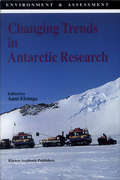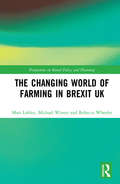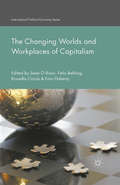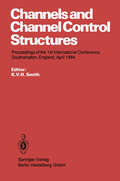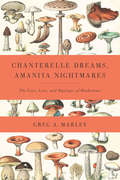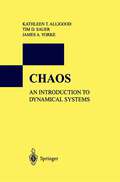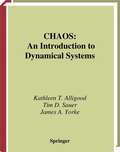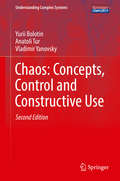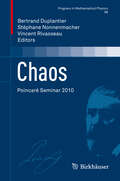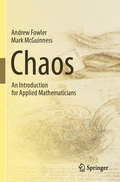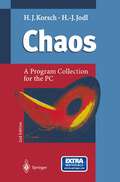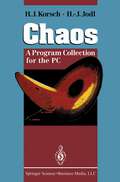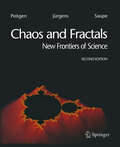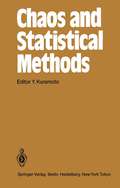- Table View
- List View
Changing Trends in Antarctic Research (Environment & Assessment #3)
by AantElzingaThe core of this volume is a report from a symposium held at the University of Goteborg in the Fall of 1991. It deals with the interplay of science and politics and how^ such interplay affects research agendas. The focus is on polar research in Antarctica, a continent that has been much in the news during the past couple of years. It gives me particular pleasure to thank all the speakers who took part in the program. All of them have many commitments and involvements in international polar research and the protection of Antarctica for its scientific and aesthetic values. The fact that such a distinguished group has been willing to come to Goteborg, to my mind attests to the importance and timeliness of our topic and the relevance of epistemological and policy issues in this field. A presentation of each speaker and author is made within the relevant chapters in the text. My interest in the Antarctic has its origins in discussions with Anders Karlqvist, the Director of the Swedish Polar Research Secretariate at the Royal Academy of Science in Stockholm. Anders and I had worked together in the early 80's in a program on Technology and Culture, among other at the Research Policy Institute in Lund. At the time he was with the Swedish Council for Planning and Coordination of Research (FRN), its Committee for Future Oriented Research headed by Torsten Hagerstrand.
The Changing U.S. Auto Industry: A Geographical Analysis
by James M. RubensteinFirst published in 1992. Routledge is an imprint of Taylor & Francis, an informa company.
The Changing U.S. Auto Industry: A Geographical Analysis
by James M. RubensteinFirst published in 1992. Routledge is an imprint of Taylor & Francis, an informa company.
Changing Urban Renewal Policies in China: Policy Transfer and Policy Learning under Multiple Hierarchies
by Giulia C. Romano"This is a very rich monograph, based on impressive fieldwork in China, which demonstrates excellent qualitative and ethnographic research skills, research integrity, and cultural perceptiveness in the analysis. This book will make a great contribution to the literature on policy transfer and and policy mobilities, and on urban politics in contemporary China, as it offers a rich understanding of the nitty-gritty practices of transferring and learning 'from abroad'."Claire Colomb, Professor of Urban Studies and Planning at the University College London, UK.This book explores the concept of Careful Urban Renewal, a concept of urban renewal that originated in Berlin in the 1980s and that was proposed to Yangzhou, a Chinese city of the wealthy province of Jiangsu, in the early 2000s. It sets out to understand whether knowledge and ideas originating in a specific setting can be transferred to another locality thousands of miles away from the point of origin, and have the chance to change the policies and the practices of the destination city. The book shows that foreign ideas can inspire ambitious reforms of the policies of a single city, but that there also exist multiple challenges to policy learning and to the rooting of new ideas in local practices. To explore these challenges, this book develops an analysis of the micro-dynamics of policy transfer, showing that there exist multiple hierarchies to which a Chinese city can be subjected, intermittently opening or closing “windows for policy learning”.
The Changing World of Farming in Brexit UK (Perspectives on Rural Policy and Planning)
by Matt Lobley Michael Winter Rebecca WheelerThe 2016 referendum resulted in a vote for the United Kingdom to withdraw from the European Union. This has led to frenzied political debate across the whole spectrum of policy, and agriculture is no exception. For the first time in a generation, the future of agriculture is unclear and unfettered by the constraints and incrementalism of the Common Agricultural Policy. This book makes an empirical contribution to the Brexit debate, bringing a social dimension to agri-Brexit and sustainable agriculture discourses. Understanding the social in the context of farmers is vital to developing a way forward on food security and agricultural sustainability. Farmers are the recipients of the market and policy signals that link to global uncertainties and challenges. This book is a commitment to understanding farmers as occupiers and managers of land. Chapters in this book explore farmers’ own aspirations and knowledge about patterns of land use and production, which underpin discussions around the environment and sustainability. There is a deficit in understanding what kind of agricultural industry we now have, following years of restructuring and repositioning. This book is an attempt to address that deficit and will appeal to students and researchers exploring agriculture, food politics and rural sociology.
The Changing World of Farming in Brexit UK (Perspectives on Rural Policy and Planning)
by Matt Lobley Michael Winter Rebecca WheelerThe 2016 referendum resulted in a vote for the United Kingdom to withdraw from the European Union. This has led to frenzied political debate across the whole spectrum of policy, and agriculture is no exception. For the first time in a generation, the future of agriculture is unclear and unfettered by the constraints and incrementalism of the Common Agricultural Policy. This book makes an empirical contribution to the Brexit debate, bringing a social dimension to agri-Brexit and sustainable agriculture discourses. Understanding the social in the context of farmers is vital to developing a way forward on food security and agricultural sustainability. Farmers are the recipients of the market and policy signals that link to global uncertainties and challenges. This book is a commitment to understanding farmers as occupiers and managers of land. Chapters in this book explore farmers’ own aspirations and knowledge about patterns of land use and production, which underpin discussions around the environment and sustainability. There is a deficit in understanding what kind of agricultural industry we now have, following years of restructuring and repositioning. This book is an attempt to address that deficit and will appeal to students and researchers exploring agriculture, food politics and rural sociology.
The Changing World Religion Map: Sacred Places, Identities, Practices and Politics
by Stanley D. BrunnThis extensive work explores the changing world of religions, faiths and practices. It discusses a broad range of issues and phenomena that are related to religion, including nature, ethics, secularization, gender and identity. Broadening the context, it studies the interrelation between religion and other fields, including education, business, economics and law. The book presents a vast array of examples to illustrate the changes that have taken place and have led to a new world map of religions.Beginning with an introduction of the concept of the “changing world religion map”, the book first focuses on nature, ethics and the environment. It examines humankind’s eternal search for the sacred, and discusses the emergence of “green” religion as a theme that cuts across many faiths. Next, the book turns to the theme of the pilgrimage, illustrated by many examples from all parts of the world. In its discussion of the interrelation between religion and education, it looks at the role of missionary movements. It explains the relationship between religion, business, economics and law by means of a discussion of legal and moral frameworks, and the financial and business issues of religious organizations. The next part of the book explores the many “new faces” that are part of the religious landscape and culture of the Global North (Europe, Russia, Australia and New Zealand, the U.S. and Canada) and the Global South (Latin America, Africa and Asia). It does so by looking at specific population movements, diasporas, and the impact of globalization. The volume next turns to secularization as both a phenomenon occurring in the Global religious North, and as an emerging and distinguishing feature in the metropolitan, cosmopolitan and gateway cities and regions in the Global South. The final part of the book explores the changing world of religion in regards to gender and identity issues, the political/religious nexus, and the new worlds associated with the virtual technologies and visual media.
The Changing Worlds and Workplaces of Capitalism (International Political Economy Series)
by Seán Ó Riain Felix Behling Rossella Ciccia Eoin FlahertyThe contributors investigate how the large scale structures of capitalism and the local social relations of workplaces and organizations shape each other. They argue for a new integration of political economy and the sociology of work and organizations.
Changjiang Riverine and Estuarine Hydro-morphodynamic Processes: In the Context of Anthropocene Era
by Zhijun DaiThis book provides a comprehensive and systematic analysis of the morphodynamic process of the Changjiang River from upstream to estuary in the Anthropocene. As the longest river in China, the Changjiang River has nurtured Chinese civilization with ample natural resources for thousands of years. Evidence highlights that the Changjiang River has experienced intensive human interference and indicated dramatic changes in the Anthropocene, including “no flood in flood season, no dry in dry season” in discharge; “less flood in flood season, more dry in dry season” in sediment; riverbed shifts from accretion to erosion; lakes in the middle-lower reach turn from sediment sink to source; estuarine tidal flat exhibits self-organization characteristics and maintains the current accretion state; estuarine branches that connect to the sea show district morphodynamic patterns; and depocenters of the submerged delta indicate periodic shifts. The book stresses that dam construction upstream, practically the Three Gorges Dam, the world’s largest hydraulic engineering project, has significant influences on the hydrology and geomorphology of the middle-lower reach but has a slight effect on estuarine delta development. The geomorphological structure of the estuarine channel is dominated by local land reclamation, navigation, and dredging. This book clarifies the river-estuary morphodynamics of the Changjiang River and indicates the general features of global mega rivers under human interference as well as their own response mechanisms. This book also exhibits the potential risk of river-estuary deltas in the future, as both material and dynamics are experiencing acceleration adjustment.
Channels and Channel Control Structures: Proceedings of the 1st International Conference on Hydraulic Design in Water Resources Engineering: Channels and Channel Control Structures, University of Southampton, April 1984
by K. V. H. SmithThe development of water resources has proceeded at an amazing speed around the world in the last few decades. The hydraulic engineer has played his part: in constructing much larger artificial channels than ever before, larger and more sophisticated control structures, and systems of irrigation, drainage and water supply channels in which the flow by its nature is complex and unsteady requiring computer-based techniques at both the design and operation stage. It seemed appropriate to look briefly at some of the developments in hydraulic design resulting from this situation. Hence the idea of the Conference was formed. The Proceedings of the Conference show that hydraulic engineers have been able to acquire a very substantial base of design capability from the experience of the period referred to. The most outstanding development to have occurred is in the combination of physical and mathematical modelling, which in hydraulic engineering has followed a parallel path to that in other branches of engineering science. The Proceedings of this Conference will give to the reader an awareness of the current state of hydraulic design in open channel flow and open channel control structures. K.V.H. Smith Editor 1. CONTROL AND DIVERSION STRUCTURES 1-3 FACTORS AFFECTING BRINK DEPTH IN RECTANGULAR OVERFALLS G.C. Christodoulou, G.C. Noutsopoulos and S.A. Andreou Dept. of Civil Engineering, National Technical Univ. of Athens, Greece.
Chanterelle Dreams, Amanita Nightmares: The Love, Lore, and Mystique of Mushrooms
by Greg Marley2011 Winner, International Association of Culinary Professionals Jane Grigson Award2011 Finalist, International Association of Culinary Professionals in the Culinary History categoryThroughout history, people have had a complex and confusing relationship with mushrooms. Are fungi food or medicine, beneficial decomposers or deadly "toadstools" ready to kill anyone foolhardy enough to eat them? In fact, there is truth in all these statements. In Chanterelle Dreams, Amanita Nightmares, author Greg Marley reveals some of the wonders and mysteries of mushrooms, and our conflicting human reactions to them. With tales from around the world, Marley, a seasoned mushroom expert, explains that some cultures are mycophilic (mushroom-loving), like those of Russia and Eastern Europe, while others are intensely mycophobic (mushroom-fearing), including, the US. He shares stories from China, Japan, and Korea-where mushrooms are interwoven into the fabric of daily life as food, medicine, fable, and folklore-and from Slavic countries where whole families leave villages and cities during rainy periods of the late summer and fall and traipse into the forests for mushroom-collecting excursions. From the famous Amanita phalloides (aka "the Death Cap"), reputed killer of Emperor Claudius in the first century AD, to the beloved chanterelle (cantharellus cibarius) known by at least eighty-nine different common names in almost twenty-five languages, Chanterelle Dreams, Amanita Nightmares explores the ways that mushrooms have shaped societies all over the globe. This fascinating and fresh look at mushrooms-their natural history, their uses and abuses, their pleasures and dangers-is a splendid introduction to both fungi themselves and to our human fascination with them. From useful descriptions of the most foolproof edible species to revealing stories about hallucinogenic or poisonous, yet often beautiful, fungi, Marley's long and passionate experience will inform and inspire readers with the stories of these dark and mysterious denizens of our forest floor.
Chaos: An Introduction to Dynamical Systems (Textbooks in Mathematical Sciences)
by Kathleen Alligood Tim Sauer J.A. YorkeBACKGROUND Sir Isaac Newton hrought to the world the idea of modeling the motion of physical systems with equations. It was necessary to invent calculus along the way, since fundamental equations of motion involve velocities and accelerations, of position. His greatest single success was his discovery that which are derivatives the motion of the planets and moons of the solar system resulted from a single fundamental source: the gravitational attraction of the hodies. He demonstrated that the ohserved motion of the planets could he explained hy assuming that there is a gravitational attraction he tween any two ohjects, a force that is proportional to the product of masses and inversely proportional to the square of the distance between them. The circular, elliptical, and parabolic orhits of astronomy were v INTRODUCTION no longer fundamental determinants of motion, but were approximations of laws specified with differential equations. His methods are now used in modeling motion and change in all areas of science. Subsequent generations of scientists extended the method of using differ ential equations to describe how physical systems evolve. But the method had a limitation. While the differential equations were sufficient to determine the behavior-in the sense that solutions of the equations did exist-it was frequently difficult to figure out what that behavior would be. It was often impossible to write down solutions in relatively simple algebraic expressions using a finite number of terms. Series solutions involving infinite sums often would not converge beyond some finite time.
Chaos: An Introduction to Dynamical Systems (Textbooks in Mathematical Sciences)
by Kathleen T. Alligood Tim D. Sauer James A. YorkeDeveloped and class-tested by a distinguished team of authors at two universities, this text is intended for courses in nonlinear dynamics in either mathematics or physics. The only prerequisites are calculus, differential equations, and linear algebra. Along with discussions of the major topics, including discrete dynamical systems, chaos, fractals, nonlinear differential equations and bifurcations, the text also includes Lab Visits -- short reports that illustrate relevant concepts from the physical, chemical and biological sciences. There are Computer Experiments throughout the text that present opportunities to explore dynamics through computer simulations, designed for use with any software package. And each chapter ends with a Challenge, guiding students through an advanced topic in the form of an extended exercise.
Chaos: Concepts, Control And Constructive Use (Understanding Complex Systems)
by Yurii Bolotin Anatoli Tur Vladimir YanovskyThis book offers a short and concise introduction to the many facets of chaos theory.While the study of chaotic behavior in nonlinear, dynamical systems is a well-established research field with ramifications in all areas of science, there is a lot to be learnt about how chaos can be controlled and, under appropriate conditions, can actually be constructive in the sense of becoming a control parameter for the system under investigation, stochastic resonance being a prime example.The present work stresses the latter aspects and, after recalling the paradigm changes introduced by the concept of chaos, leads the reader skillfully through the basics of chaos control by detailing the relevant algorithms for both Hamiltonian and dissipative systems, among others.The main part of the book is then devoted to the issue of synchronization in chaotic systems, an introduction to stochastic resonance, and a survey of ratchet models. In this second, revised and enlarged edition, two more chapters explore the many interfaces of quantum physics and dynamical systems, examining in turn statistical properties of energy spectra, quantum ratchets, and dynamical tunneling, among others.This text is particularly suitable for non-specialist scientists, engineers, and applied mathematical scientists from related areas, wishing to enter the field quickly and efficiently.From the reviews of the first edition: This book is an excellent introduction to the key concepts and control of chaos in (random) dynamical systems [...] The authors find an outstanding balance between main physical ideas and mathematical terminology to reach their audience in an impressive and lucid manner. This book is ideal for anybody who would like to grasp quickly the main issues related to chaos in discrete and continuous time. Henri Schurz, Zentralblatt MATH, Vol. 1178, 2010.
Chaos: Poincaré Seminar 2010 (Progress in Mathematical Physics #66)
by Bertrand Duplantier Stéphane Nonnenmacher Vincent RivasseauThis twelfth volume in the Poincaré Seminar Series presents a complete and interdisciplinary perspective on the concept of Chaos, both in classical mechanics in its deterministic version, and in quantum mechanics. This book expounds some of the most wide ranging questions in science, from uncovering the fingerprints of classical chaotic dynamics in quantum systems, to predicting the fate of our own planetary system. Its seven articles are also highly pedagogical, as befits their origin in lectures to a broad scientific audience. Highlights include a complete description by the mathematician É. Ghys of the paradigmatic Lorenz attractor, and of the famed Lorenz butterfly effect as it is understood today, illuminating the fundamental mathematical issues at play with deterministic chaos; a detailed account by the experimentalist S. Fauve of the masterpiece experiment, the von Kármán Sodium or VKS experiment, which established in 2007 the spontaneous generation of a magnetic field in a strongly turbulent flow, including its reversal, a model of Earth’s magnetic field; a simple toy model by the theorist U. Smilansky – the discrete Laplacian on finite d-regular expander graphs – which allows one to grasp the essential ingredients of quantum chaos, including its fundamental link to random matrix theory; a review by the mathematical physicists P. Bourgade and J.P. Keating, which illuminates the fascinating connection between the distribution of zeros of the Riemann ζ-function and the statistics of eigenvalues of random unitary matrices, which could ultimately provide a spectral interpretation for the zeros of the ζ-function, thus a proof of the celebrated Riemann Hypothesis itself; an article by a pioneer of experimental quantum chaos, H-J. Stöckmann, who shows in detail how experiments on the propagation of microwaves in 2D or 3D chaotic cavities beautifully verify theoretical predictions; a thorough presentation by the mathematical physicist S. Nonnenmacher of the “anatomy” of the eigenmodes of quantized chaotic systems, namely of their macroscopic localization properties, as ruled by the Quantum Ergodic theorem, and of the deep mathematical challenge posed by their fluctuations at the microscopic scale; a review, both historical and scientific, by the astronomer J. Laskar on the stability, hence the fate, of the chaotic Solar planetary system we live in, a subject where he made groundbreaking contributions, including the probabilistic estimate of possible planetary collisions. This book should be of broad general interest to both physicists and mathematicians.
Chaos: An Introduction for Applied Mathematicians
by Andrew Fowler Mark McGuinnessThis is a textbook on chaos and nonlinear dynamics, written by applied mathematicians for applied mathematicians. It aims to tread a middle ground between the mathematician's rigour and the physicist’s pragmatism.While the subject matter is now classical and can be found in many other books, what distinguishes this book is its philosophical approach, its breadth, its conciseness, and its exploration of intellectual byways, as well as its liberal and informative use of illustration. Written at the graduate student level, the book occasionally drifts from classical material to explore new avenues of thought, sometimes in the exercises. A key feature of the book is its holistic approach, encompassing the development of the subject since the time of Poincaré, and including detailed material on maps, homoclinic bifurcations, Hamiltonian systems, as well as more eclectic items such as Julia and Mandelbrot sets. Some of the more involved codes to produce the figures are described in the appendix.Based on lectures to upper undergraduates and beginning graduate students, this textbook is ideally suited for courses at this level and each chapter includes a set of exercises of varying levels of difficulty.
Chaos: A Program Collection for the PC
by Hans Jürgen Korsch Hans-Jörg JodlChaos: A Program Collection for the PC presents an outstanding selection of executable programs with introductory texts to chaos theory and its simulation. Students in physics, mathematics, and engineering will find a thorough introduction to fundamentals and applications in this field. Many numerical experiments and suggestions for further studies help the reader to become familiar with this fascinating topic. The second edition includes one CD-ROM, the executable programs are Windows 95 compatible.
Chaos: A Program Collection for the PC
by Hans Jürgen Korsch Hans-Jörg Jodl Timo HartmannThis new edition strives yet again to provide readers with a working knowledge of chaos theory and dynamical systems. It does so through parallel introductory explanations in the book and interaction with carefully-selected programs supplied on the accompanying disk. The programs enable readers, especially advanced-undergraduate students in physics, engineering, and math, to tackle relevant physical systems quickly on their PCs, without distraction from algorithmic details. For the third edition of Chaos: A Program Collection for the PC, each of the previous twelve programs is polished and rewritten in C++ (both Windows and Linux versions are included). A new program treats kicked systems, an important class of two-dimensional problems.
Chaos: A Program Collection for the PC
by H.J. Korsch H.-J. JodlAn outstanding selection of executable programs with introductory texts to chaos theory and its simulation. Students in physics, mathematics, and engineering will find a thorough introduction to fundamentals and applications in this field, backed by many numerical experiments and suggestions for further studies.Ten executable programs and numerous examples are included on two 3 1/2" MS-DOS diskettes.
Chaos: The World of Nonperiodic Oscillations (Understanding Complex Systems #Vol. 84)
by Otto E. Rössler Christophe LetellierWritten in the 1980s by one of the fathers of chaos theory, Otto E. Rössler, the manuscript presented in this volume eventually never got published. Almost 40 years later, it remains astonishingly at the forefront of knowledge about chaos theory and many of the examples discussed have never been published elsewhere. The manuscript has now been edited by Christophe Letellier - involved in chaos theory for almost three decades himself, as well as being active in the history of sciences - with a minimum of changes to the original text.Finally released for the benefit of specialists and non-specialists alike, this book is equally interesting from the historical and the scientific points of view: an unconventionally modern approach to chaos theory, it can be read as a classic introduction and short monograph as well as a collection of original insights into advanced topics from this field.
Chaos and Complex Systems: Proceedings of the 5th International Interdisciplinary Chaos Symposium (Springer Proceedings in Complexity)
by Stavros G. Stavrinides Mehmet OzerThis book presents the proceedings of the “5th International Interdisciplinary Chaos Symposium on Chaos and Complex Systems (CCS).” All Symposia in the series bring together scientists, engineers, economists and social scientists, creating a vivid forum for discussions on the latest insights and findings obtained in the areas of complexity, nonlinear dynamics and chaos theory, as well as their interdisciplinary applications. The scope of the latest Symposium was enriched with a variety of contemporary, interdisciplinary topics, including but not limited to: fundamental theory of nonlinear dynamics, networks, circuits, systems, biology, evolution and ecology, fractals and pattern formation, nonlinear time series analysis, neural networks, sociophysics and econophysics, complexity management and global systems.
Chaos and Complex Systems: Proceedings of the 4th International Interdisciplinary Chaos Symposium
by Stavros G. Stavrinides, Santo Banerjee, Suleyman Hikmet Caglar and Mehmet OzerComplexity Science and Chaos Theory are fascinating areas of scientific research with wide-ranging applications. The interdisciplinary nature and ubiquity of complexity and chaos are features that provides scientists with a motivation to pursue general theoretical tools and frameworks. Complex systems give rise to emergent behaviors, which in turn produce novel and interesting phenomena in science, engineering, as well as in the socio-economic sciences. The aim of all Symposia on Chaos and Complex Systems (CCS) is to bring together scientists, engineers, economists and social scientists, and to discuss the latest insights and results obtained in the area of corresponding nonlinear-system complex (chaotic) behavior. Especially for the “4th International Interdisciplinary Chaos Symposium on Chaos and Complex Systems,” which took place April 29th to May 2nd, 2012 in Antalya, Turkey, the scope of the symposium had been further enlarged so as to encompass the presentation of work from circuits to econophysics, and from nonlinear analysis to the history of chaos theory. The corresponding proceedings collected in this volume address a broad spectrum of contemporary topics, including but not limited to networks, circuits, systems, biology, evolution and ecology, nonlinear dynamics and pattern formation, as well as neural, psychological, psycho-social, socio-economic, management complexity and global systems.
Chaos and Fractals: New Frontiers of Science
by Heinz-Otto Peitgen Hartmut Jürgens Dietmar SaupeThe fourteen chapters of this book cover the central ideas and concepts of chaos and fractals as well as many related topics including: the Mandelbrot set, Julia sets, cellular automata, L-systems, percolation and strange attractors. This new edition has been thoroughly revised throughout. The appendices of the original edition were taken out since more recent publications cover this material in more depth. Instead of the focussed computer programs in BASIC, the authors provide 10 interactive JAVA-applets for this second edition.
Chaos and Statistical Methods: Proceedings of the Sixth Kyoto Summer Institute, Kyoto, Japan September 12–15, 1983 (Springer Series in Synergetics #24)
by Y. KuramotoChaos: Concepts, Control and Constructive Use (Understanding Complex Systems)
by Yurii Bolotin Anatoli Tur Vladimir YanovskyThe study of physics has changed in character, mainly due to the passage from the analyses of linear systems to the analyses of nonlinear systems. Such a change began, it goes without saying, a long time ago but the qualitative change took place and boldly evolved after the understanding of the nature of chaos in nonlinear s- tems. The importance of these systems is due to the fact that the major part of physical reality is nonlinear. Linearity appears as a result of the simpli?cation of real systems, and often, is hardly achievable during the experimental studies. In this book, we focus our attention on some general phenomena, naturally linked with nonlinearity where chaos plays a constructive part. The ?rst chapter discusses the concept of chaos. It attempts to describe the me- ing of chaos according to the current understanding of it in physics and mat- matics. The content of this chapter is essential to understand the nature of chaos and its appearance in deterministic physical systems. Using the Turing machine, we formulate the concept of complexity according to Kolmogorov. Further, we state the algorithmic theory of Kolmogorov–Martin-Lof ¨ randomness, which gives a deep understanding of the nature of deterministic chaos. Readers will not need any advanced knowledge to understand it and all the necessary facts and de?nitions will be explained.
